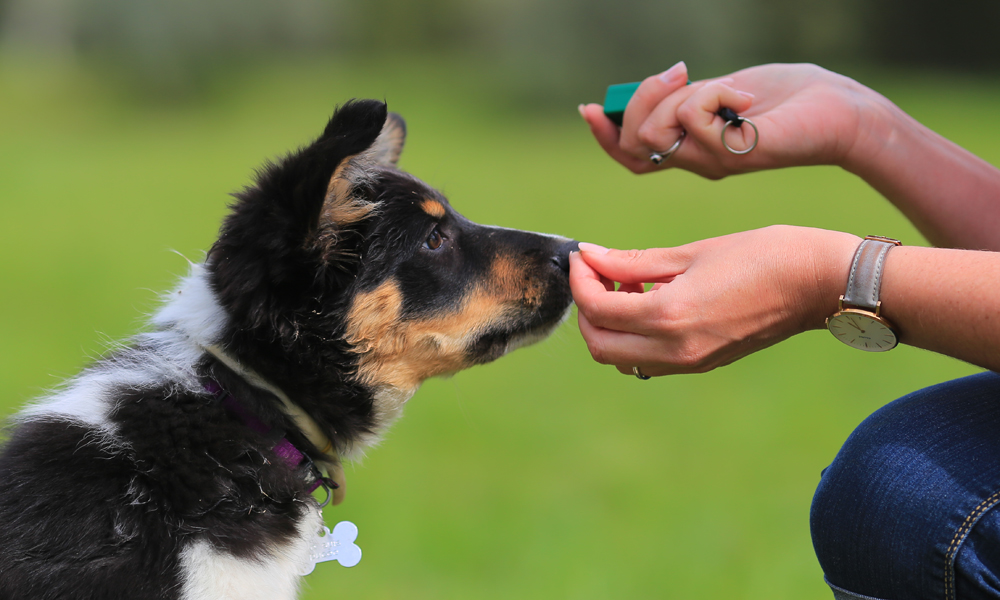Clicker training is a communication tool for dog training. When your dog does the correct action, you sound the clicker to “mark” the moment, followed by a tasty treat for positive reinforcement. Of course, that means the first step is conditioning your dog to recognize the clicker is good and means good things are coming. Trainers and pet parents like the precision of clicker training. You can mark good behavior the second it happens, sending a clear message to your dog.
What makes clicker training effective?
A clicker gives instant feedback, especially when the timing is critical. For “come,” you click the moment they turn and start trotting toward you. For “drop it,” click when their mouth opens to release the toy. For “lie down,” give a click when the belly meets the floor. Later on, if you want to try agility training, clicking is an easy way to mark when they jump a hurdle.
To break it down, here’s how the clicker works with dogs. When your dog correctly follows a command, these three elements reinforce the behavior:
- Clicker: The sound of the click sends a cue
- Marker: The dog connects their behavior with the click
- Reward: Dog receives positive reinforcement for the behavior
Clicker training creates a happy, positive moment between you and the dog. The positive reinforcement at the end gives your dog an incentive to listen and increases the likelihood he will repeat it the next time. Delivering the click at the right time, every time they perform the correct behavior, followed by a treat, is key to successful clicker training.
3 steps to start clicker training your dog
Like many things you teach your dog, it’s best to start with the simplest elements and work your way up.
Step 1. Connect the clicker with a reward
Spend a few days building the clicker-reward connection. There are two ways to do it:
Treats: Simply offer a treat and click when they take it.
Hand feeding: At mealtimes, offer small handfuls of kibble, letting the dog eat from your palm. Every time they take the food, mark the action with a click.
Step 2. Create the pause between click and reward
Next, teach your dog to anticipate the reward by building a few seconds between the sound of the click and receiving the food. Hit the clicker, then scatter a few pieces of kibble or training treats on the ground, away from your dog.
For the next few days, stick to this method at mealtimes, one handful at a time — as well as doling out treats.
As your dog catches on, make it more challenging by adding a few seconds between the click and releasing the food.
Step 3. Start your first training session
Closed hand feeding is a great choice to start clicker training. It teaches your dog impulse control while linking perfectly to the earlier hand-feeding method.
How does closed-hand feeding with clicker training work? When you offer food, your hand is closed around it. Then be still and give your dog a few minutes to work through their methods to get you to open it — they’ll sniff, nudge, paw, lick, mouth and whine.
When they finally back off and look at you, mark it with a click. Then open your hand to let them eat! If your dog is ready for a challenge, lengthen the pause between click and reward.
What’s next with clicker training?
Once your dog masters closed-hand feeding with the help of clicker training, future training sessions will be easier to learn because you’ve set a precedent. When you click to mark a new behavior, it gets the dog’s attention: Hey, something important happened!
Are there alternatives to clicker training?
For the lessons of clicker training to take root, consistency is crucial. When your dog has a real-life moment of good behavior outside of your training session — such as listening when you call them away from barking out the window — you will want to catch that.
But one misconception about clicker training is if you don’t have access to your clicker, you can’t mark the moment. That’s not true.
Still, if you think keeping a physical clicker just gives you one more thing to keep track of, you can choose an alternative method. The point of clicker training is “marking the moment” when your dog performs the correct behavior. Instead of buying a clicker you can mark the moment by:
- Snapping your fingers
- Clicking your tongue
- Giving vocal praise — using short words like “good” or “yes”
- Giving hand signals such as a “thumbs up” or a shoulder tap — particularly for dogs with hearing loss
Bring out the superstar in your dog!
The ultimate goal of training is bringing out your dog’s potential so they can become a superstar!
Behind every superstar dog is a committed, loving human, one who’s determined to bring out their dog’s best! NutriSource’s SuperStar Soft & Chewy Training Treats are the perfect snack to have on hand during training sessions or to reinforce good behavior.
They’re delicious and don’t crumble in your pocket. And best of all, every purchase spreads the goodness. We donate 100% of the proceeds to great causes that help kids, dogs, veterans and so many more. Pick up a bag today at your favorite pet retailer and learn more about the NutriSource SuperStar Giving Program.


